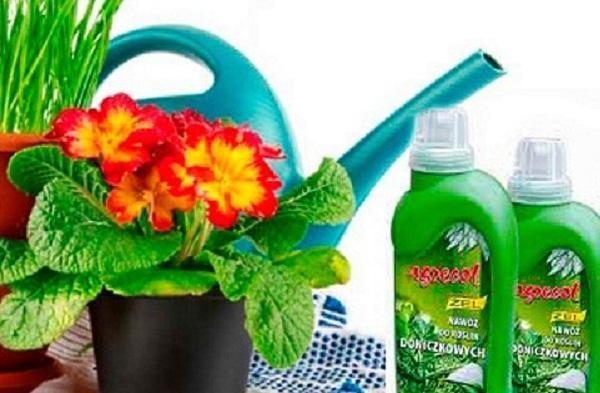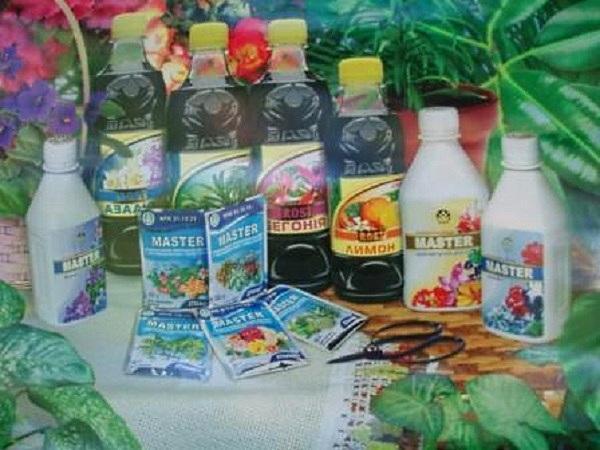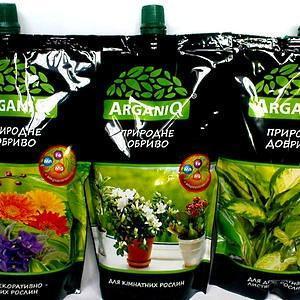The good appearance of indoor plants and flowers depends on the choice and application of fertilizers
 When growing indoor plants and flowers, you should be aware of the fact that at certain points in their vegetative development they need fertilizing. In this case, do not confuse fertilizers for garden flowers and shrubs with fertilizers that are specifically designed for indoor species and specimens.
When growing indoor plants and flowers, you should be aware of the fact that at certain points in their vegetative development they need fertilizing. In this case, do not confuse fertilizers for garden flowers and shrubs with fertilizers that are specifically designed for indoor species and specimens.

- liquid;
- granular;
- pressed;
- tablet;
- powder.
The more digestible elements of the root plant system are liquid fertilizers.
Basic fertilizing elements
Fertilizers for indoor plants include:
- nitrogen, it is this element that contributes to the constant development of plants, if it is not enough in the soil, then the process of wilting of the leaves begins, a change in their color;
- no less important is phosphorus, its low concentration slows down the vegetative development process, the leaves change their bright color to faded;
- if there is little potassium in the soil of the flower pot, the plant either does not bloom at all, or throws out inflorescences that are too small;
- the wilting of the foliage of indoor plants can be the reason for the lack of sulfur;
- if the foliage dies off at the very tops of the plants, and the rest of the crown as a whole looks intact, then the plant does not have enough calcium;
- no less important and necessary are elements such as iron, molybdenum, magnesium, manganese, copper and boron.
All fertilizers for indoor flowers and branchy green plants are classified into two types - organic and mineral.
Organic fertilizers for indoor plants
Organics are natural fertilizers, so-called organic compounds of plant or animal origin. These include the excrement of domestic pets, bird droppings (geese, chickens, ducks, pigeons), peat bogs, and plant composts.
 Exactly in organic fertilizers there are all the necessary nutrients that improve the air, water and natural-climatic balance, significantly improve the structure of the soil intended for growing indoor plants. Organic matter is a fertile soil for assimilation mineral fertilizers, creating various chemical compounds that accelerate the development of beneficial microorganisms.
Exactly in organic fertilizers there are all the necessary nutrients that improve the air, water and natural-climatic balance, significantly improve the structure of the soil intended for growing indoor plants. Organic matter is a fertile soil for assimilation mineral fertilizers, creating various chemical compounds that accelerate the development of beneficial microorganisms.
Mineral fertilizers for indoor plants
The mineral group of fertilizers includes:
- nitrogen fertilizers;
- potash;
- phosphate fertilizers.
There are simple options, and there are too concentrated.
 It is the mineral groups that are useful in the case when organic matter depletes itself in full, the soil in pots is depleted. This process is often called feeding.
It is the mineral groups that are useful in the case when organic matter depletes itself in full, the soil in pots is depleted. This process is often called feeding.
Top dressing is relevant during the period of active plant growth and before flowering, decorative flowering and decorative deciduous plants are especially urgently needed.
Only perfectly healthy plants are fertilized. It is strictly forbidden to fertilize plants during the dormant period, plants that have not yet taken root after planting in the ground.
Among the proposed fertilizers for indoor flowers, there are many that are not applied to the soil, but dissolve in water and are intended for spraying foliage and flowers with a spray bottle.The solution is sprayed in the evening or in cloudy weather to reduce the risk of foliage burns.
The most common nitrogen fertilizers include:
- ammonia;
- calcium;
- sodium nitrate;
- urea;
- ammonium sulfate.
Phosphate fertilizers are divided into simple and double superphosphates. Simple ones contain up to twenty percent phosphorus in their composition, and the second type is saturated with phosphorus by half.
From potash fertilizers in floriculture are applicable wood ash, potassium sulfate and potassium saltpeter.
Among the fertilizers offered by domestic producers, you can often find complex fertilizers, the so-called universal fertilizers, which include all mineral elements in a proportional ratio, useful for the development of a particular plant or indoor flower, which are the best fertilizers for indoor plants.
If houseplants are fertilized with several types of fertilizers, you need to know their comparability.
Below is a diagram of fertilizers that can be combined in one composition, which will not harm the plant and will not cause an unexpected chemical negative reaction.

Fertilization rules for flowering indoor plants:
- an oversupply of fertilizer for indoor plants is also detrimental, like a deficit;
- plants absorb fertilizers well only in the active phase of growth and flowering;
- in winter, top dressing should be rare due to low natural light, due to which the absorption of nutrients by the plant slows down;
- you should not carry out top dressing even in a hot time;
- do not allow the fertilizer solution to get on the foliage, if it is recommended in the instructions for use;
- for young flowers, the consistency of fertilizers is used half as weak in its characteristic characteristics than for already rooted ones;
- each period of vegetative development requires the introduction of a certain type of fertilizer: at the beginning, nitrogen fertilization should be activated, during the flowering period and before it, phosphorus and potassium substances are used;
- you cannot fertilize the plants prematurely without watering the soil thoroughly, if this is not done, you can burn the roots of the plant.